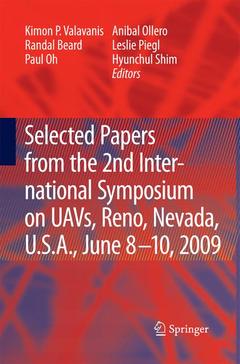Selected papers from the 2nd International Symposium on UAVs, Reno, U.S.A. June 8-10, 2009, 2010
Langue : Anglais

In the last decade, signi?cant changes have occurred in the ?eld of vehicle motion planning, and for UAVs in particular. UAV motion planning is especially dif?cult due to several complexities not considered by earlier planning strategies: the - creased importance of differential constraints, atmospheric turbulence which makes it impossible to follow a pre-computed plan precisely, uncertainty in the vehicle state, and limited knowledge about the environment due to limited sensor capabilities. These differences have motivated the increased use of feedback and other control engineering techniques for motion planning. The lack of exact algorithms for these problems and dif?culty inherent in characterizing approximation algorithms makes it impractical to determine algorithm time complexity, completeness, and even soundness. This gap has not yet been addressed by statistical characterization of experimental performance of algorithms and benchmarking. Because of this overall lack of knowledge, it is dif?cult to design a guidance system, let alone choose the algorithm. Throughout this paper we keep in mind some of the general characteristics and requirements pertaining to UAVs. A UAV is typically modeled as having velocity and acceleration constraints (and potentially the higher-order differential constraints associated with the equations of motion), and the objective is to guide the vehicle towards a goal through an obstacle ?eld. A UAV guidance problem is typically characterized by a three-dimensional problem space, limited information about the environment, on-board sensors with limited range, speed and acceleration constraints, and uncertainty in vehicle state and sensor data.
Editorial.- Accurate Modeling and Robust Hovering Control for a Quad-rotor VTOL Aircraft.- Modeling and System Identification of the muFly Micro Helicopter.- Vision-based Position Control of a Two-rotor VTOL miniUAV.- A Survey of Motion Planning Algorithms from the Perspective of Autonomous UAV Guidance.- An Efficient Path Planning and Control Algorithm for RUAV’s in Unknown and Cluttered Environments.- On the Generation of Trajectories for Multiple UAVs in Environments with Obstacles.- Integration of Path/Maneuver Planning in Complex Environments for Agile Maneuvering UCAVs.- A Cost Effective Tracking System for Small Unmanned Aerial Systems.- Vision-Based Road-Following Using Proportional Navigation.- A Vision-Based Automatic Landing Method for Fixed-Wing UAVs.- A Vision-Based Guidance System for UAV Navigation and Safe Landing using Natural Landmarks.- Autonomous Vision-Based Helicopter Flights Through Obstacle Gates.- Exploring the Effect of Obscurants on Safe Landing Zone Identification.- Low-Cost Visual Tracking of a Landing Place and Hovering Flight Control with a Microcontroller.- Landing and Perching on Vertical Surfaces with Microspines for Small Unmanned Air Vehicles.- Automating Human Thought Processes for a UAV Forced Landing.- Autonomous Autorotation of Unmanned Rotorcraft using Nonlinear Model Predictive Control.- Multimodal Interface Technologies for UAV Ground Control Stations.- Multi-UAV Simulator Utilizing X-Plane.- UAS Flight Simulation with Hardware-in-the-loop Testing and Vision Generation.- Multi-UAV Cooperation and Control for Load Transportation and Deployment.- Flyphone: Visual Self-Localisation Using a Mobile Phone as Onboard Image Processor on a Quadrocopter.- A Rotary-wing Unmanned Air Vehicle for Aquatic Weed Surveillance and Management.-Development and Evaluation of a Chase View for UAV Operations in Cluttered Environments.- Design Methodology of a Hybrid Propulsion Driven Electric Powered Miniature Tailsitter Unmanned Aerial Vehicle.
Publishes the latest research findings, not published anywhere else Presents current status of unmanned aviation Discusses levels of autonomy and sensor-based navigation Includes real case studies
Date de parution : 11-2014
Ouvrage de 529 p.
15.5x23.5 cm
Date de parution : 03-2010
Ouvrage de 529 p.
15.5x23.5 cm
Mots-clés :
Model Predictive Control; microcontroller; model; modeling; simulation; system; system identification
© 2024 LAVOISIER S.A.S.



